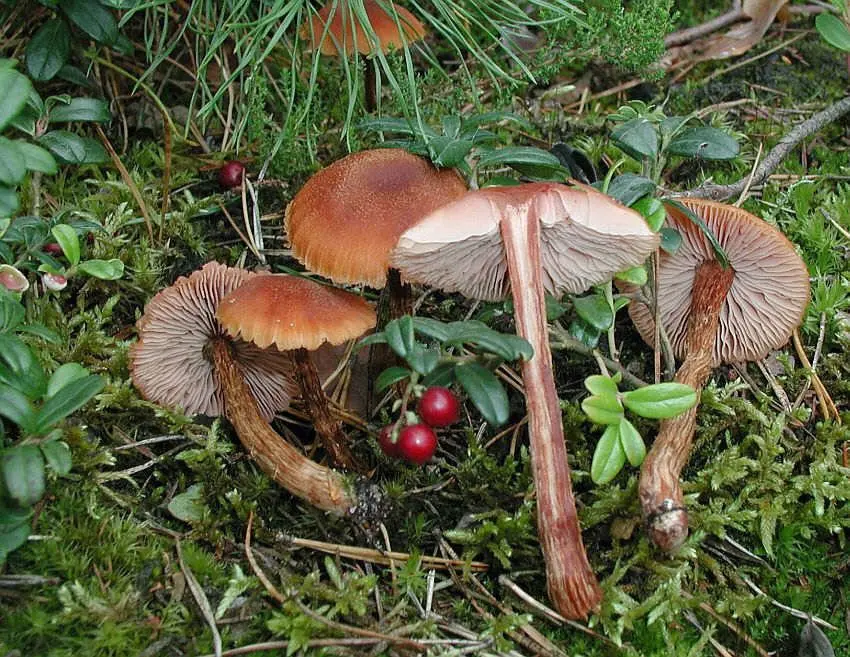Contents
Large lacquer (Laccaria proxima)
- Division: Basidiomycota (Basidiomycetes)
- Subdivision: Agaricomycotina (Agaricomycetes)
- Class: Agaricomycetes (Agaricomycetes)
- Subclass: Agaricomycetidae (Agaricomycetes)
- Order: Agaricales (Agaric or Lamellar)
- Family: Hydnangiaceae
- Genus: Laccaria (Lakovitsa)
- Type: Laccaria proxima (large lacquer)
- Clitocybe proxima
- Laccaria proximella

The nearest lacquer (Laccaria proxima), which is also called the close lacquer or the large lacquer, is a mushroom belonging to the Hydnangiaceae family, the Laccaria genus.
External description of the fungus
The fruiting body of the nearest lacquer (Laccaria proxima) consists of a cap and a stem, is thin, but quite fleshy. The diameter of the caps of an adult mushroom is from 1 to 5 (sometimes 8.5) cm, in immature mushrooms it has a hemispherical shape. As it matures, the cap opens to an irregularly conical shape with truncated edges (sometimes the shape of the cap becomes flattened-conical). Often the edges of the cap are unevenly wavy, and in its central part there is a depression. Often the edges of the cap are torn, and 1/3 of it is characterized by radially arranged translucent stripes. In the center, the cap is characterized by the presence of radially arranged fibers, sometimes scales are visible on it. The color of the nearest lacquer cap is predominantly orange-brown, rusty or red-brown. In the center of the cap, the shade is slightly darker than in other parts of it.
The mushroom flesh has the same color as the surface of the mushroom, however, at the base of the stalk it is often a dirty purple. The taste of the pulp is a pleasant mushroom, and the smell resembles an earthy, sweet mushroom aroma.
The mushroom hymenophore is characterized by sparsely located plates. Often, the plates descend along the leg with teeth, or adhere to it. In young mushrooms, the lacquers of the nearest plate have a bright pink color; as they ripen, they darken, becoming dirty pink.
The nearest lacquer (Laccaria proxima) has a cylindrical leg, sometimes expanded at the bottom. Its length varies within 1.8-12 (17) cm, and its thickness – 2-10 (12) mm. The color of the stem is reddish-brown or orange-brown, with cream or white longitudinal fibers visible on its surface. At its base, there is usually a light white edge.
Mushroom spores are white in color, sizes are in the range of 7.5-11 * 6-9 microns. The shape of the spores mostly resembles an ellipse or a wide ellipse. On the surface of fungal spores there are small spikes 1 to 1.5 µm high.

Habitat and fruiting season
The range of the nearest lacquer (Laccaria proxima) is quite extensive and cosmopolitan. The fungus prefers to grow in wooded areas with coniferous and deciduous trees. Grows in small colonies or singly. The distribution of this type of lacquer is not as great as in the case of pink lacquers. Fruiting occurs throughout the summer and the first half of autumn. Lakovitsa nearest settles mainly in damp and mossy areas of the forest.
Edibility
In most guides to mushroom growing, the close lacquer is noted as an edible mushroom with a low level of nutritional value. Sometimes the clarification is attributed that this variety of lacquer has the ability to accumulate arsenic, which makes it dangerous to human health.
Similar species, distinctive features from them
In appearance, the nearest lacquer (Laccaria proxima) resembles a pink lacquer (Laccaria laccata). True, that leg is perfectly smooth, therefore, by the absence of spikes and scales, it is distinguished from Laccaria proxima.
Another mushroom similar to the nearest lacquer (Laccaria proxima) is called two-color lacquer (Laccaria bicolor). The plates of that fungus have a purple color, which is uncharacteristic for a close lacquer.
All varieties of lacquers named in this article grow mixed in the forests of Our Country. In drier areas, two-tone and pink lacquers grow, but Laccaria proxima prefers to grow in swampy, marshy and damp areas. A distinctive feature of large lacquers is that they do not spread along the ground with a continuous carpet, so the mushroom picker will not trample them when harvested. The main distinguishing feature of this type of mushroom is a rough, as if cut with a knife, leg. When you feel it, you get the impression that some unfortunate mushroom picker simply did not complete the work.









